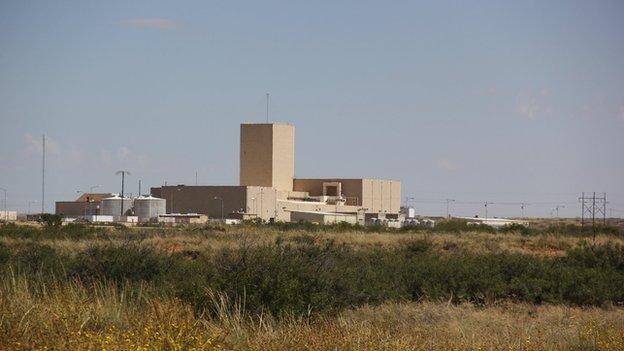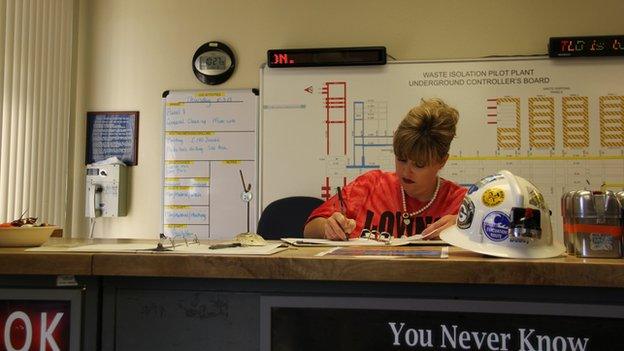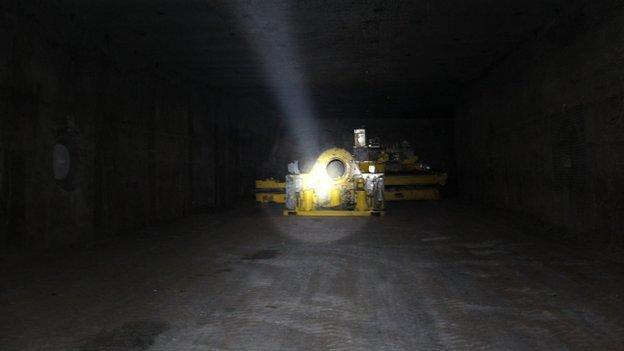The radiation leak site that wants more nuclear waste
- Published
The BBC's Jane O'Brien takes an underground tour of the nuclear waste site before the radiation leak
A recent radiation leak at America's only nuclear waste repository threatens the future of waste storage in the country. But leaders in the city of Carlsbad, New Mexico, still want their area to be a destination for America's radioactive history.
Carlsbad works underground.
On the road into the city, derricks pump oil from deep in the Earth.
Residents go to work mining potash, a raw material used in fertiliser. Others give tours at Carlsbad Caverns National Park.
And some of Carlsbad's underground workers make a half-mile (0.8km) journey into the earth not to take from the ground, but to bury the wastes of human invention.
This is WIPP, the Waste Isolation Pilot Plant, the only long-term geologic repository for nuclear waste in the United States.

WIPP opened in south-eastern New Mexico in 1999
While other locales across the US have fought mightily to prevent the establishment of similar operations, almost all of Carlsbad is sanguine about the storage of nuclear materials just a 40-minute drive from the centre of town.
That confidence has been tested this month after a radiation leak and the initial report 13 workers had tested positive for radioactive contamination.
And as the only permanent storage facility for nuclear waste, problems at WIPP create problems for the larger US nuclear defence complex, including delays of already scheduled shipments from around the country.
But it is the first serious incident in WIPP's history, and Carlsbad still appears to have confidence, albeit slightly shaken, in the site.
In fact, town officials are hoping their corner of New Mexico can be the home of even more nuclear waste.
Radiation leak
The facility, 26 miles (42km) east of the city, looks from the outside like any industrial site, except for the large, empty canisters sitting in the car park.
But 2,150ft (655m) below, WIPP is a cool cavern, with wide pathways cut out of pure salt on every side. Each storage section, known as a panel, is 13ft high, 33ft wide and 300ft long.
WIPP can only take certain types of waste. It must all be from US defence projects and be transuranic - contaminated by elements beyond uranium in the periodic table in which radioactivity is particularly long-lived. Most of its waste is solid: radioactive gloves, tools and debris.
Stand next to canisters of these types of waste for an hour and you'll be dosed with about half the average amount of radiation an American receives in a year.
Workers wear radiation counters and spend limited time in direct proximity to the waste. Most of it emits radioactivity through particles known as alpha-emitters, which are seriously dangerous only if ingested and inhaled.
In October 2013, WIPP officials and Carlsbad residents told the BBC the site's excellent safety record gave them confidence.
In early February, that record ended, when a small fire on a lorry hauling salt closed down the underground portion of the site. Then late on 14 February, underground sensors detected radiation. More tests confirmed that two radioactive particles, isotopes of americium and plutonium, were found on aboveground air filters.

Before the leak, WIPP boasted an excellent safety record
Later, preliminary test results indicated 13 employees working above ground that day had inhaled or ingested radioactive material.
On Wednesday, energy department officials said follow-up testing on the employees was negative for both isotopes. Such a result "indicates that levels were extremely low and the employees are unlikely to experience any serious health effects", Carlsbad field office manager Jose Franco wrote.
WIPP officials said the amount of radioactivity detected aboveground, about 3 mRems, is less than in the exposure of a chest x-ray (10 mRems). An investigation is underway to determine what exactly happened.
'Proud of what we do'
In the 1970s, Carlsbad's main industry, potash, was on an economic downswing just as a proposal to bury nuclear waste in underground salt deposits near Lyons, Kansas, fell apart.
Carlsbad officials realised nuclear waste disposal could be a stable industry. The area had salt deposits and plenty of people willing and able to work underground.
A local oversight board spent years studying safety concerns, and the plant received its first waste shipment in 1999. Since then, more than 90,000 cu m have come to rest here from around the US.
When the BBC visited in October, city development director John Waters said the city was "proud of what we do here".

The underground entrance to the lift at WIPP
"We want people to know that we're helping the nation take care of a problem that the whole world is experiencing," he said. "We want to be the example of how to do it right."
About 1,000 people in Carlsbad, a city of 26,000, are employed by WIPP or related contractors, and the site's annual budget is about $215m (£129m) per year. While oil and potash have been booming again in south-eastern New Mexico, they have busted before. WIPP promised a stable economic base for lifelong residents.
"Those are our high-paying jobs, they support our baseball teams, they are part of our community," says Eddy County Commissioner Susan Crockett, who represents Carlsbad.
Before the leak, most residents told the BBC that the nuclear storage didn't worry them - or even cross their minds. But now there are signs of increased concern.
A town hall meeting with WIPP officials about the incident attracted about 300 residents. The local newspaper, the Carlsbad Current-Argus, reported a sharp rise in appointments for people wanting whole body scans for radiation, external.
"One citizen came [to the town hall] with a very simple question, 'Is my family safe in Carlsbad?'" says city councillor Jason Shirley.
He says the answer is yes, that safety measures at WIPP did exactly what they were supposed to do in such a situation.

Room 7 in Panel 7, empty in October 2013, was the location where airborne radiation was first detected underground
What happens next at WIPP could also determine the future of another potential nuclear waste project in the region.
Eddy County and neighbouring Lea County have proposed making an aboveground storage site for radioactive waste produced by power plants.
Known as the Eddy-Lea Energy Alliance (ELEA), it is intended to be an interim site for spent fuel awaiting a permanent US repository. The two counties have three companies on board - firms already in town for WIPP - to create private storage if the state and federal governments permit it.
When asked recently whether the leak would affect ELEA's future, Mr Waters said it was a separate project that would have to "stand on its own merits anyway".
WIPP was long held up as a rare success story in nuclear waste. But with its safety record no longer clean, its economic promise will again be tested against the potential perils.
For now, Carlsbad seems to be keeping the faith.
"Moving forward, their safety record is going to be phenomenal," Ms Crockett says. "There's no reason for us to not feel safe having WIPP there."

- Published4 March 2014
- Published6 December 2012